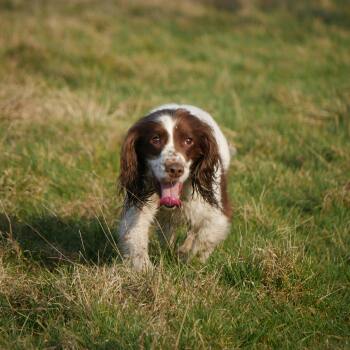English Springer Spaniels

English Springer Spaniel: Your Energetic, Ever-Faithful Adventure Buddy
If you’re on the lookout for a cheerful, athletic, and loyal canine companion, the English Springer Spaniel might just be your perfect match. These dogs have a zest for life and an endless supply of tail wags, making them a favorite for families and active pet owners alike.
Why English Springer Spaniels Win Hearts
- People-Pleasers: Springers thrive on human connection and love being part of the action—whether that’s running around the backyard or cuddled up on the couch.
- Smart and Eager to Learn: Their trainability makes them an excellent choice for first-time dog owners or those interested in dog sports like agility or obedience.
- Built for Adventure: Bred to flush out game in the field, Springers have energy to spare. Hikes, games of fetch, or doggy playdates? Count them in.
- Friendly with All: With proper socialization, these spaniels are welcoming to kids, other dogs, and even houseguests.
Things to Know Before Bringing One Home
- Needs a Job: These energetic pups need physical and mental stimulation to stay balanced. Without it, they can become anxious or bored.
- Velcro Dogs: They form tight bonds with their humans and don’t love being left alone. Separation anxiety is common.
- Noise Alerts: They’re often quick to sound the alarm if they hear something suspicious—which can mean excessive barking for some households.
- Mood Matters: Temperament can vary depending on breeding. Choosing a reputable breeder or rescue is essential for a well-balanced pup.
A Glimpse Into Springer Spaniel History
Originally developed in 19th-century England as a hunting companion, the English Springer Spaniel was named for its skill in "springing" game from hiding. Their history as working dogs makes them enthusiastic and dependable, but their affectionate nature has made them a beloved family pet across the globe. Today, they shine not only in the field but also in therapy work, search and rescue, and canine competitions.
Springers typically live 12 to 15 years and do best in homes where their energy and loyalty are put to good use. If you're someone who enjoys staying active and wants a dog that's always up for fun, the English Springer Spaniel could be your dream dog.
Common Health Concerns in English Springer Spaniels
- Neurological Conditions— Springers can be prone to epilepsy, including a rare condition known as “Springer Rage Syndrome”—a seizure-related form of sudden aggression. Most cases of epilepsy are manageable with lifelong medication. If your dog experiences a seizure or sudden behavior change, talk to your vet immediately.
- Eye Issues— This breed has a higher risk of glaucoma, cataracts, and Progressive Retinal Atrophy (PRA), all of which can impair vision. Annual eye exams can help detect these conditions early. Keep an eye out for cloudy eyes, night blindness, or excessive squinting.
- Bleeding Disorders— Inherited conditions like Von Willebrand’s disease or thrombocytopenia can interfere with proper blood clotting. These may not show up until surgery or an injury occurs, so pre-surgical blood work is always recommended.
- Heart Problems— Congenital heart defects such as Patent Ductus Arteriosus (PDA) may appear in puppies, while murmurs and valve disorders can develop later in life. Regular veterinary checkups can help catch these issues early.
- Diabetes— Springers are slightly more prone to diabetes than many breeds. Signs include increased thirst, urination, appetite, and weight loss. With insulin and a controlled diet, most diabetic dogs live long, happy lives.
- Hip and Elbow Dysplasia— Joint issues can lead to discomfort, especially in older Springers or those carrying excess weight. Early diagnosis through X-rays and proactive joint care can improve long-term mobility.
- PFK Deficiency (Phosphofructokinase Deficiency)— This inherited metabolic disorder impacts energy production, leading to fatigue and muscle pain. Genetic testing is available for early diagnosis, especially useful in breeding decisions.
- NCL (Neuronal Ceroid Lipofuscinosis)— A serious neurological disease that appears in young dogs and causes balance issues, vision loss, and cognitive decline. Genetic screening can identify carriers.
- Skin & Coat Issues— Seborrhea, allergies, and autoimmune skin diseases like Pemphigus Foliaceus can cause dry, itchy, or greasy skin. Treatments often include medicated shampoos and immune-modulating medications.
- Bone Pain in Growing Dogs— Young Springers may suffer from eosinophilic panosteitis—an inflammatory bone condition causing shifting leg pain. While uncomfortable, it’s usually temporary and treatable with anti-inflammatory meds.
Ready to Learn More? We’re Here to Help!


